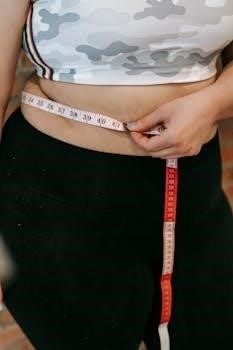
dickies coveralls size guide
Finding the right fit for Dickies coveralls is crucial for comfort and functionality․ This guide will help you understand how to measure yourself accurately, use size charts, and consider fit preferences․ It ensures you select the correct size for your needs, enhancing your work experience․
Understanding the Importance of Proper Fit
A proper fit in Dickies coveralls isn’t just about comfort; it’s about safety and efficiency․ Coveralls that are too tight can restrict movement, making tasks difficult and potentially leading to discomfort or injury․ Conversely, coveralls that are too loose can be cumbersome, snag on equipment, and pose a safety hazard․ The right fit allows for a full range of motion, ensuring you can perform your job effectively without being hindered by your clothing․ It also enables you to work comfortably for extended periods․ Knowing your correct measurements and understanding how Dickies sizes translate to those measurements is paramount․ Additionally, consider the layering you might need underneath your coveralls, especially in colder environments․ A too-tight fit can restrict blood flow, leading to discomfort in long periods․ This guide aims to assist you in finding coveralls that fit perfectly, enhancing your overall work experience․

Measuring for Dickies Coveralls
Accurate measurements are key to finding the right Dickies coverall size․ This section guides you through the process, focusing on neck, chest, and sleeve length․ Proper measuring ensures a comfortable and functional fit․
Neck Measurement Guidelines
To measure your neck for Dickies coveralls, begin by placing the measuring tape around the base of your neck, where a shirt collar would naturally sit․ It’s important to keep the tape level and not too tight; you should be able to comfortably insert one forefinger between the tape and your neck․ This ensures the measurement isn’t constricting and allows for ease of movement and comfort while wearing your coveralls․ This measurement is crucial for determining the correct collar size, which impacts overall comfort, especially if you plan on buttoning the coverall all the way up․ Remember, this measurement is a circumference, so make sure you get the full way around the neck․ Record this number in inches for the most accurate comparison to size charts, as Dickies size charts typically use inches for sizing․ Following this guideline will help in achieving the best fit around the neck and shoulders, which leads to overall comfort․
Chest Measurement Guidelines
For accurately measuring your chest for Dickies coveralls, it’s best to have someone assist you․ Stand naturally with your arms relaxed at your sides․ Take the measuring tape and position it around the fullest part of your chest, ensuring the tape passes under your armpits and over your shoulder blades at the back․ Keep the tape horizontal and snug but not tight․ Make sure the tape is level all the way around, so it does not slip or dip down in the back, which can lead to an incorrect measurement․ It’s crucial to breathe normally while taking this measurement, to avoid artificially expanding or contracting your chest․ The goal is to get a measurement that represents your chest size when you’re in a relaxed position․ Record this measurement in inches, as Dickies uses inches in its sizing charts for coveralls; This is a key measurement for determining the correct coverall size, ensuring it fits comfortably across your chest and allows for freedom of movement․
Sleeve Length Measurement Guidelines
To measure your sleeve length for Dickies coveralls accurately, start by bending your arm slightly․ Place one end of the measuring tape at the bottom of the collar, at the center back of your neck․ Then, measure along the outside of your arm, down over the elbow, and continue to the bottom of your wrist․ It is essential to keep your arm slightly bent, to ensure that you are measuring the sleeve length you will need while moving and working․ Do not measure with your arm straight, as this will result in an inaccurate measurement․ Make sure the tape follows the natural curve of your arm․ The tape should be held firmly but not too tight․ If you are measuring yourself, it can be helpful to use a mirror to ensure the measuring tape is correctly aligned․ Record this measurement in inches․ This measurement is crucial for ensuring that the sleeves of your coveralls will not be too short or too long, which could hinder your movement or create safety hazards․ Remember to measure both arms and use the longer measurement if they differ․

Dickies Coveralls Size Charts
Dickies provides size charts for men and women, using chest and neck measurements for shirts and coveralls․ These charts help convert your body measurements into the correct sizes, ensuring a proper and comfortable fit for your workwear․
Men’s Coveralls Size Chart Overview
The men’s Dickies coveralls size chart primarily uses chest and neck measurements to determine the appropriate size․ Chest measurements are taken around the fullest part of the chest, keeping the tape under the armpits and around the shoulder blades, while neck measurements are taken around the base of the neck․ These measurements correlate to sizes ranging from small to 7XL, with chest sizes from 34-36 inches to 70-72 inches and neck sizes from 14-14․5 inches to 23-23․5 inches․ It’s important to note that these measurements are body measurements and not garment measurements․ If your measurements fall between sizes, it’s generally recommended to choose the larger size for a more comfortable fit, especially if layering clothing underneath the coveralls is anticipated․ The size chart is a general guide, and the actual fit may vary slightly․ Also consider that Dickies coveralls come in regular and tall lengths, which is separate from the chest and neck sizing․
Women’s Coveralls Size Chart Overview
Dickies women’s coverall sizing considers chest and waist measurements․ The chest is measured around the fullest part, and the waist is measured at the natural waistline․ These measurements help determine sizes ranging from small to larger sizes․ While specific numerical measurements for women’s coveralls weren’t explicitly detailed, it’s crucial to consult the brand’s specific size chart; Unlike men’s sizing, women’s charts often include hip measurements as well․ If your measurements fall between sizes, it’s advisable to opt for the larger size, especially if you prefer a looser fit or plan to wear layers underneath․ Keep in mind that fit preferences can vary, and some women might prefer a more tailored or a looser fit․ The elasticity in the back of the waistband adds to freedom of movement and is a feature to consider when choosing the right size․ Remember the size chart is a guide only, and it’s always best to refer to Dickies’ specific charts․
Specific Dickies Coverall Sizing Considerations
When choosing Dickies coveralls, consider the regular and tall length options․ Fit preferences also play a role; some prefer a looser fit for layering, while others prefer a true-to-size fit for better mobility․ Choose wisely․
Regular vs․ Tall Length Options
Dickies coveralls often come in regular and tall length options, catering to different body proportions․ The primary difference lies in the inseam and overall garment length․ Regular lengths are designed for individuals of average height, while tall lengths provide extra length in the torso and legs․ If you find standard sizes often feel short or ride up uncomfortably, opting for a tall size might be beneficial․ Tall sizes typically add 2 inches to the sleeve length and 1․5 inches to the body length, ensuring a better fit for taller individuals․ To determine which length is best for you, consider your usual pants inseam and how coveralls fit on your frame․ Trying on both options or comparing measurements to a well-fitting garment can help you make the correct choice․ This ensures that your coveralls provide adequate coverage and freedom of movement without being too short or excessively baggy․
Fit Preferences⁚ Loose vs․ True-to-Size
When selecting Dickies coveralls, understanding fit preferences is key․ Some individuals prefer a looser fit, which allows for greater freedom of movement and the ability to layer clothing underneath․ This can be especially useful in colder environments or for jobs requiring a wider range of motion․ Others prefer a true-to-size fit, which provides a more streamlined and less bulky appearance․ A true-to-size fit is often favored when minimal bulk is desired, and where the coveralls are not used over multiple layers․ If you typically wear a medium in other clothing, a medium in Dickies coveralls will likely fit true-to-size․ However, if you plan on wearing heavier clothing underneath or prefer a more relaxed feel, consider going one size up․ Ultimately, the decision depends on personal comfort and the intended use of the coveralls․ It’s important to try on different sizes or compare measurements to find the perfect balance of comfort and functionality for your specific needs․

Sizing Tips and Recommendations
When between sizes, always choose the larger one for comfort and layering․ Consider what you’ll wear underneath, as this can affect the fit․ Remember, Dickies’ sizing is generally true, but personal preference also matters․
Dealing with Measurements Between Sizes
It’s common to find that your measurements fall between the standard sizes provided on a Dickies size chart․ When this happens, it’s generally recommended to opt for the larger size․ This approach ensures that you have enough room for comfortable movement and prevents the coveralls from feeling too restrictive, especially during physical work․ Choosing the smaller size might result in a tighter fit that limits your range of motion and could potentially cause discomfort throughout the day․ Remember, coveralls are designed to be worn over clothing, so a slightly looser fit is often preferred․ Additionally, consider the type of tasks you’ll be performing while wearing the coveralls․ If your work involves a lot of bending or reaching, having extra room will be beneficial․ If you prefer a more tailored fit, you might consider getting the larger size and then making minor alterations if necessary․ Ultimately, comfort and functionality should be your main goals when selecting a size․
Considering Layering Under Coveralls
When selecting the right size for your Dickies coveralls, it’s crucial to think about the layers you’ll be wearing underneath․ If you typically wear just a t-shirt, you can choose a size that fits closer to your actual measurements․ However, if you frequently wear multiple layers, such as a sweatshirt, thermal underwear, or a heavy work shirt, you’ll need to factor this into your sizing decision․ Opting for a size larger than your standard measurement will ensure you have enough room to move comfortably without feeling constricted․ The added bulk of extra clothing can significantly impact the fit of your coveralls, making a larger size a necessity rather than a preference․ Consider the climate you’ll be working in and the type of work you will be doing․ This will inform how many layers you need․ A looser fit will also provide better ventilation and flexibility․ If you are uncertain, it’s best to size up․

Finding Your Perfect Dickies Coverall Size
Selecting the correct size for your Dickies coveralls is essential for both comfort and optimal performance․ By diligently following the measuring guidelines provided and consulting the size charts, you can confidently choose a fit that works best for you․ Remember to consider your personal preferences, such as whether you prefer a looser or more fitted style, as well as the types of clothing you will be wearing underneath the coveralls․ If your measurements fall between sizes, it is generally advisable to go up to the next larger size to ensure adequate freedom of movement․ With attention to detail and a thorough understanding of your own measurements, you can find the perfect Dickies coverall size․ Taking your time with this process will lead to a more comfortable and efficient work experience, allowing you to focus on the task at hand․ Proper fit promotes safety and productivity․